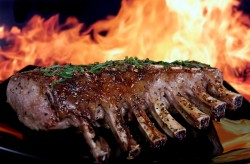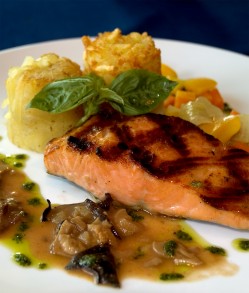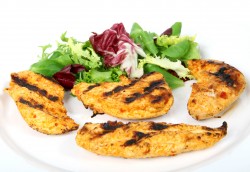The perfect end to a warm summer day is watching fireflies while sitting around a fire pit! Add a grill above the fire, and you have all the ingredients for an amazing summer party!
From simply toasting marshmallows to cooking rotisserie chicken, fire pits allow flexibility and variety in outdoor cooking. Customizing your fire pit to fit your yard makes installation easy!
Fire Pit Grills: Features
Fire pits usually burn wood or charcoal, although gas inserts are available. Permanent fire pits are usually brick or stone built up

around a shallow hole in the ground for the fire with a wire grill and/or a spit over the fire for cooking. Patio fire pits are often made of cast iron or copper.
Cast iron is heavy and retains heat well, whereas copper is more portable and cools more quickly. Sojoe makes fire pits from steel coated with porcelain, creating an earthy look and mimicking the temperatures of stone or brick pits. Even though patio fire pits are not actually dug into the ground, the legs holding the fire bowl stand low to the ground.
Fire Pit Grills: Pros and cons
Fire pits are accessible from every side of the pit, allowing multiple people to cook instead of assigning one or two as chefs. However, because more people will be near the fire, more precautions should be taken to avoid an uncontrolled fire. Brick and stone pits can be custom made to fit your yard, and they absorb and retain heat well, which is good for cooking, but can be a hazard around kids.
Though copper, cast iron, and Sojoe fire pits are heavy, they are not permanent. You can take them to where you want the cookout instead of always bringing the cookout to them. Because fire pits are on, or low to, the ground, stooping or sitting could make cooking difficult for some. Low chairs or cushions set around the pit could relieve some discomfort.
Fire Pit Grills: Is it for you?
Fire pits can cook almost anything you want, involve all your guests in the fun of cooking, and add a campfire ambiance to your evening. The variety of fire pits allows you to make or find the perfect one for your space and personal preferences.
Being low to the ground may be a drawback for some, but if that is not a problem for you, then end a summer evening drinking coffee and eating s’mores around your fire pit grill!
Go back to Types of Grills Main Page
Go to iGrillBBQ.com Home Page from Fire Pit Grills


